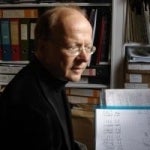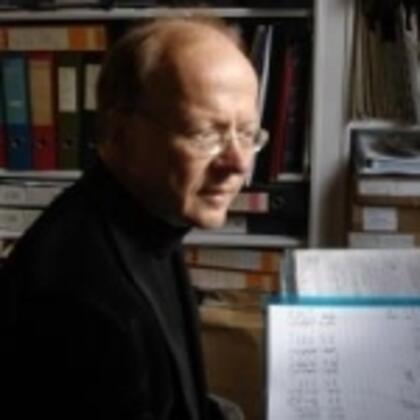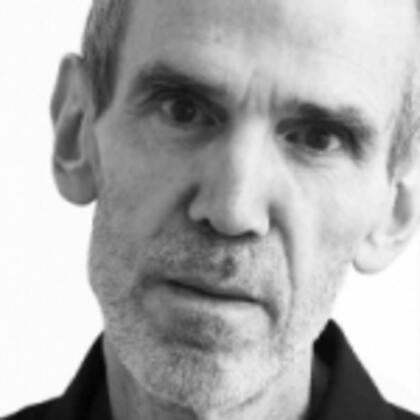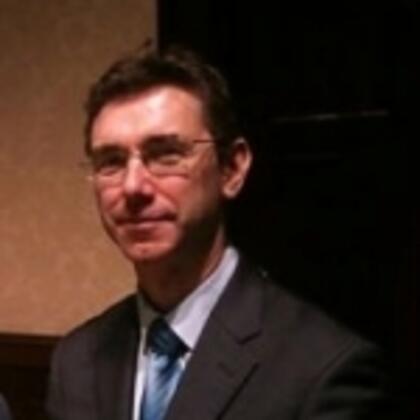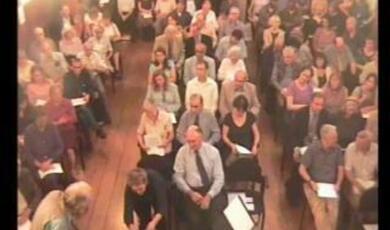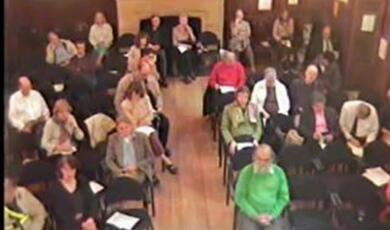Erik Satie: Erik Satie and Visual Art
Share
- Details
- Text
- Audio
- Downloads
- Extra Reading
STUDY DAY IN COLLABORATION WITH THE INSTITUTE OF MUSICAL RESEARCH, SCHOOL OF ADVANCED STUDY, UNIVERSITY OF LONDON AND KINGSTON UNIVERSITY
In addition to his music, Satie left a remarkable set of writings, including Le Piégede Méduse (1913) featuring music for prepared piano. Satie was a colourful figure in the early 20th century Parisian avant-garde. He was a precursor to later artistic movements such as minimalism, repetitive music, and the Theatre of the Absurd.
This study day will include material on French cinema, lecture/recitals and a performance.
This part of the study day included the following talks:
Composers' Forum: The Impact of Satie on music today by Howard Skempton, Michael Parsons and James Nye. Chaired by Paul Archbold
Satie in performance by Grace Cheung
Erik Satie and Visual Art by Simon Shaw-Miller
Download Text
Background information on Satie's study/ Rose-Croix Music/ Cabaret influence
Satie had his first music lessons with Monsieur Vinot, the organist of St Leonard's church in Honfleur and also a graduate of the École Niedermeyer, from whom he learned about Gregorian chant. Later, in 1879, when Satie was 13 years old, with his stepmother's encouragement, he entered the Conservatoire National de Musique et de Déclamation in Paris. It has been documented that he was not a virtuosic pianist like Debussy and Poulenc at the time. He surely knew about his technical limitations and therefore, shrewdly utilised the instrument in a different way, mainly not wanting to exploit the maximum potential of a piano a
Satie in performance, with historical recordings
Grace Cheung
t the time. To name a few examples of what composers in the past would strive for on the piano: playing with wide dynamic range, composing notes using a wide span of register, virtuosic passages, cantabile, legato melodic passages with clear phrasing, harmonies based on the dissonance and resolution relationship. All these factors are put together to give a successful performance. However, the Rose Croix music has its unique style which does not offer pianists the chance to express oneself with the conventional approach - namely the performance criteria mentioned above. Prélude de La Porte Héroïque du Ciel is one of these Rose Croix pieces that consist of consecutive unresolved seventh chords which forms the jigsaw-like motifs and they are arranged in 'mosaic structure' as Gowers described (1965-1966, p.15). All the technical and aesthetic demands on performers have been stripped down to a bare minimum. It is almost as if Satie deliberately led the audience or even the performer to concentrate on the music alone, but not the interpretation of it. Perhaps knowing the cross arts influence from his cabaret years, it is not too exaggerating for me to qualify Satie as a poet who wrote music. Interestingly, Satie did once put the two disciplines together in his private writing, which shows that he did have the concept of composers as poets. Undoubtedly, he could have composed music from a poet's point of view rather than a pianist's point of view. Below is part of the content from his writing Don't let us be confused,
'Composers can be divided into swots, & poets. The former impress the public, & critics. As examples of poets I would point to Liszt, Chopin, Schubert, Mussorgsky; as a swot, Rimsky-Korsakov. Debussy was the classic poet-musician, among his followers are several sorts of swot musicians. Mozart's craft is light, & Beethoven's heavy, which few people understand; but both are poets. That is everything. P.S. Wagner was a dramatic poet...?
Knowing how close spiritually he was with Debussy and what a passive role he played when it came to impressing the critics, it is obvious that he was hinting himself as a poet through this short article.
Introducing Prélude de La Porte Héroïque du Ciel
The piece in discussion today is Prélude de La Porte Héroïque du Ciel,Satie provided this prelude to Jules Bois's esoteric drama, who was a journalist at the time who sought to establish the cult of Isis, a central part of ancient Egyptian religion. The drama casts a poet who is sent forth by Christ on a dangerous mission to supplant the Virgin Mary by the cult of Isis.
Now, let's look at how Satie advertised his piece in his poetic style (translated by Volta, 1996, p.184)
(Le Guide du Concert, III, 35, I June 1912.):
'I wrote this Prelude in 1894, for the work by M. Jules Bois.
M. Roland Manuel asked me in 1911 for authorisation to orchestrate this corner of my life.
That is the simple story of a little prelude; a little prelude worked in ivory like a tapestry of sound, a little prelude full of mystical sweetness, a little prelude full of ecstatic joy, a little prelude full of intimate goodness.
The form of it is naive and chaste; its harmonies are meditative and white, and follow the so respectable and touching conventions rightly established by our August Predecessors, the Venerated Masters of Antiphony, which is Supreme, Unique, Impeccable, Triumphant, Anonymous, Fascinating and Phenomenal.'
Here is the score published by Salabert in 1912, the first edition. As we can see, apart from the musical notation, all we have are performance indications like 'superstitieusement', 'avec déférence', 'éviter toute exaltation sacrilège' but no other performance decisions.
Despite these mystical descriptive terms, and the purpose of this prelude as an esoteric drama, Orledge wrote, 'The occult never penetrated beneath the surface of his Rose-Croix music. Apart from being slow, hieratic and ritualistic, it is in no way descriptive of the plays associated with it, for it has its own independent and purely musical logic.' (1990, p.44) Another comment made by Contamine de Latour refers to his use of descriptive terms, (in Erik Satie intime, Souvenirs de jeunesse, Com'dia 3/5/6 Aug 1925; see Satie Remembered, p.27), he relates how Satie decided one day, with great jubilation, to replace the standard tempo marks (lent, grave, etc.) with his own made-up expressions (Without pride, With amazement, even whiter if possible, etc.) which addressed the pianist's feelings rather than his or her technique.' (Volta, 1996, p.169) Here, I ask myself this question, 'Isn't it true to say each pianist is entitled to have his own feelings and this means a different interpretation every time when the piece is performed?'
With such arbitrary findings, I compared this prelude to Satie's other piano pieces before and after the Rose Croix Period to see how often and when, if any, that Satie applied performance markings - dynamics, phrase marks. The result is quite straightforward; there are performance decisions written in pieces composed before the Prelude, for exampleGnossiennes, (1889), and pieces composed after the Prelude, e.g. Pièces Froides and Danse de travers (1897).
This simple observation proves that Satie had thought about performance decisions but deliberately left them out and replaced them with mystical descriptive terms. My initial thoughts are: Satie would like no dynamic change and no expressive phrasing at all throughout the whole piece. This suggests a very plain performance and the musical notes will justify themselves. To look at this in a completely opposite angle, performers are then open to all interpretations. In an attempt to narrow down my choices, I have turned to Gowers' article on Rose-Croix music (Gowers, 1965-1966) for inspiration.
Patrick Gowers had christened 'Punctuation form' for pieces like this Prelude, in which motifs are found throughout and the piece is structured or in Gowers' term, 'punctuated' by recurring motifs. He also suggested listening to this type of music as prose, 'I would suggest that the way to listen to this piece is to let the punctuation phrases slip by almost unnoticed and concentrate on the chain, thinking of it as far as possible as a whole, rather than as sections divided by a response in the manner of a litany.'(1965-1966, p.19)
My hypothesis on Satie's performance decisions
Agreeing to Gowers' point of view on the idea of 'prose-like structure', my immediate thought is to turn to the reading of prose for reference. If one is to listen to the prelude as if it is prose, it would make sense for the performer to interpret the music in the manner of reciting prose. There is a possibility that Satie had this in mind as his association with cabaret artists from his early musical career has been well documented. Satie entered the Chat Noir by the end of 1887 and then the Auberge du Clou, it is vital to acknowledge the influence of his cabaret acquaintances on him. Albert Tinchant, Vital Hocquet, George Auriol, Alphonse Allais, Vincent Hyspa and Victor Fumet, who were either pianists, poets, humorists, or the combination of any of the above had somehow shaped Satie as a mystical, poetic, humoristic composer. In order to understand what Satie, from the angle of a poet, might have in mind on how this piece should be played, I tried to understand briefly the nature of the French language. According to the nature of French pronunciation, one is to 'pronounce each syllable with approximately equal strength and to maintain for each vowel its full quality' (Tranel, 1987, p.35), unlike English poems which emphasize strongly the stressed syllables and reduce the vowels of unstressed syllables'. Philip Ball also mentioned in The Music Instinct (2010, p.360) that French songs tends to have a rather regular pulse, as in French, the durations of adjacent vowels are more similar. If the above concepts are to be applied to this prelude, the hypothesis of not having much dynamic change and having each note played with more or less equal balance throughout the whole piece will become a valid option.
Introducing Poulenc historical recording
Proceeding to a historical recording, the 1956 recording with Francis Poulenc as the pianist that I am going to discuss today is the earliest recording that I can find, and possibly the earliest recording of this piece which exists (thirty-one year after Satie's death). Unlike his contemporary musician friends, for example Poulenc and Stravinsky, whose recordings provide endless potential for research work on performance practice in the last decades, Satie did not follow suit and he managed to avoid having any of his own recordings done during his lifetime. As a result, any recording that has a link to Satie the composer will be worthwhile to look at.
Recorded in Poulenc's Correspondence (Buckland, 1991, p.313)Poulenc's friendship with Satie only lasted from 1916-1924. Although, it was a short eight-year friendship, Poulenc knew Satie fairly well, both musically and spiritually. Here are some interesting comments obtained by Stéphane Audel during his interview with Poulenc.
'I [Poulenc] know everything about Satie' (Audel, 1978, p.64)
'satie played the piano very badly, especially towards the end of his life.' (Audel, 1978, p.70)
'Although Satie is not the most outstanding pianist and his piano at home was 'completely unplayable'. (ibid)
If what Poulenc said about Satie's piano is true, it gave him the excuse or the privilege to try out his new ideas on several musician friends' homes, e.g. Cocteau's, Milhaud's, Auric's and Poulenc's. However, judging by the chronological order of when they met each other - Poulenc knew Satie in 1916 at Ricardo Vines, his piano teacher's house. However, the year of the composition is 1894, twenty-two years before they met each other. Therefore, I do not see how Poulenc would have heard Satie playing the Prélude at his home. Even if Poulenc might have heard other pieces from Satie, his later compositions are quite different from the Rose Croix pieces. Also, having commented Satie as a bad pianist, one would not expect Poulenc to look upon Satie as a model in terms of his piano playing.
Before, I go on to play the recording, I would like to show you the annotated score, based on the 1912 edition that I used at the beginning of the presentation. In this annotated score, you can see all the performance markings (e.g. agogic accents, dynamic marking, outlined motives) which I added after listening to Poulenc's recording.
I have identified 17 different motifs and 2 punctuation phrases in this Prélude. They are clearly outlined by rectangular boxes and named under M1, M2, etc for motifs and PP for punctuation phrases. Yellow highlights represent moments where agogic accents are applied. Pink highlights are for rests that Poulenc ignored, and finally the brown colour highlights the omitted motives. The rest of the performance decisions are annotated alongside the musical notations.
Poulenc had omitted almost two lines of music in this recording, which intrigued me a great deal[1]. I have looked into the different editions of this Prelude and apart from the correction of the misprint of the F sharp note as A sharp (it is the eleventh crotchet in the last line, on the first page of the music which Poulenc attentively spotted and corrected in his performance), the 1968 edition by Salabert has no more difference from the 1912 version. Besides, Professor Orledge advised me that the early 1912 edition is the same as the original 1894 edition in Jules Bois' play and also the reprint in Le Coeur (an esoteric monthly) in March 1894. Therefore, it is impossible that Poulenc would have seen a version without those two lines of music. Here is the question, 'What was Poulenc trying to reveal?'Could that be his criticism over Satie's work? Another interesting fact is that he never tells performers to slow down at the end of his piano music and in fact, he always specifically asks performers not to slow down! Surprisingly, he did in this prelude. Provided that applyingritardando at the end of the piece is never his taste, was he trying to offer something that he thought Satie would have approved?
Here, we can see how Poulenc applied detailed performance decisions on the use of articulation, pedal, dynamics, expression and tempo. In order to obtain more objective observation, I have also compared several other recordings by various performers ranging from the year 1977 to 2006. These pianists are Reinbert de Leeuw (1977), Bill Quist (1979), Jean-Yves Thibaudet (2003), and Bojan Gorisek (2006). Only from comparing these four recordings, the findings show a huge amount of discrepancies. For the presentation today, I have only selected a few examples that show significant differences.
Poulenc 1956
Reinbert de Leeuw 1977
Bill Quist 1979 Vinyl
Jean-Yves Thibaudet 2003
Bojan Gorisek 2006
Articulation
legato throughout the piece, with accents placed over some consecutive crotchet chords
Pedalling
Pedal change after every crotchet beat.
Pedal sustained across quaver rests
(Octave chord in M1, M2 does not sustain for 5 crotchet beats)
Example 1
Bojan Gorisek - Bass note D from the semibreve is pedalled through till the end of the piece. (after the RIDEAU mark)
Dynamics
Varies throughout the piece ranging from mp (my suggestion) to ffrelatively.
Whenever there are descriptive words, there are changes in dynamics or touch (Poulenc responding to Satie's words on the score)
Example 2.
Jean-Yves Thibaudet - At M12, he used subito forte for the block chords.
Expression
show evidence of response to words appear throughout the score
e.g. p for 'superstitiously'; cresc. ff for 'with respect'
Example 3. Bill Quist - Poulenc excerpts
Bill Quist - treated M14 as a separate motif rather than it being part of the long phrase.
Tempo
Steady, around mm. crotchet = 47
Ritardando in various bars, also responding to motifs
Ritardando is applied at the end of the piece
Pause is added before the reprise of the opening motif
Where RIDEAU is written, the crotchet rest is omitted
Example 4
Reinbert de Leeuw - No ritardandoat the last motif
Omission
Poulenc has skipped 9 consecutive motifs in the second page of the score - highlighted area.
Quaver rests have been ignored
RIDEAU- he did not hold for 5 crotchet beats and the rest is ignored.
Example 5
Reinbert de Leeuw - RIDEAU - 5 crotchet beats were held clearly with crotchet rest followed.
Conclusion
I think we all agree how arbitrary the interpretation can be of this Prelude, the use of dynamics on the same motif can be fortissimo or piano. Rests can be clearly heard or ignored altogether. I find it hard to convince myself if this 'free-style' was what Satie had in mind purely because Satie himself is never much of an improvised person. Based on his mannerism, one would have an impression that Satie was very precise and organised, this can been understood by the appearance he portrayed for the outside world, the careful calculation while composing, the attentive dots (punctuation marks) he left in his lecture notes; All these make the performance style of 'open to any interpretation' a bit out of place. Poulenc's historical recording however, could be a criticism to Satie's work or it could be him trying to make the piece his own by interpreting it in his own style or the conventional Romantic period performance practice. Bearing in mind that after Poulenc and Satie fell out with each other, Satie refused to even see Poulenc on his death bed even though, Poulenc still had much respect on him. Poulenc once said in 1954 that 'His [Satie's] influence on my music was immediate and profound . . . Even today, I still ask myself 'What would Satie have thought of this?' . . . He was a wizard who was able to divine the sense of my personality.' (Buckland, 1991, p.313) May I assert Poulenc's recording as some kind of tribute to this innovative twentieth century composer rather than an immediate answer to Satie's piano performance style?
©Grace Cheung, Gresham College 2010
Reference
Books
Audel, S. (1978) My Friends and Myself. London: Dennis Dobson.
Ball, P. (2010) The Music Instinct. London: Bodley Head.
Buckland, S. (1991) 'Echo and Source' Selected Correspondence 1915-1963. London, Victor Gollancz Ltd.
Orledge, R. (1990) Music in the Twentieth Century: Satie the Composer.1st edn. Cambridge: Cambridge University Press.
Satie, E. (1994) Satie, seen through his letters. 2nd edn. London: Marion Boyars.
Tranel, B. (1987) The Sounds of French: an introduction. Cambridge: Cambridge University Press.
Volta, O. (ed.) (1996) A mammal's notebook. London: Atlas Press.
Whiting, S.M. (1999) Satie the Bohemian: From Cabaret to Concert Hall. New York: OUP.
Journals
Gowers, P. (1965 - 1966) 'satie's Rose Croix Music (1891-1895)',Proceedings of the Royal Musical Association, 92nd Sess. pp. 1-25.
Recordings
Satie, E. ( 1998) The Early Piano Work. Performed by Reinbert de Leeuw [CD] Germany: Philips Classics (462 161-2)
Satie, E. (1979) Piano Solos of Erik Satie. Performed by Bill Quist [Vinyl] US :Windham Hill Records (WHS C-1008)
Satie, E. (2003) Complete Solo Piano Works. Performed by Jean-Yves Thibaudet [CD] Decca (CD 000289 473 6202 9)
Satie, E. (2006) Complete Piano Works and Songs Volume 10. Performed by Bojan Gorisek & Jane Manning [CD] Audiophile Classics
Satie, E. (2007) Socrate/ Masse des Pauvres/ Poulenc Piano Pieces. Piano pieces Performed by Francis Poulenc [CD] London: Cherry Red Record (EL ACMEM130CD)
[1]I intend to believe that the omission of 9 motifs by Poulenc is a deliberate act, and here are my reasons behind this:
1. There was no need to cut the piece short in order to fit in a record because the technology of Long Player recording allows music that lasts longer than 4 minutes which is roughly the time needed to record the whole Prelude. An earlier recording which he did in 1950 and was documented in Francis Poulenc Echo and Source Selected Correspondence 1915-1963 that he 'have made a long record of piano music, on one side Satie...on the other side, Poulenc. (Columbia ML 4399)' (1991, p.181) If he already had access to recording techniques that could hold music that exceeds 4 minutes in 1950, there is no reason for him to go back to less efficient recording methods when he did this recording of the prelude in 1956.
2. The motifs that he skipped were '14, pp1.3, pp2.3, 4.1, 7, 9, M16, 5, 12' this shows that he had ignored a new motif (M16) and this cannot be simply a mistake from his part.
3.Poulenc has orchestrated three early pieces by Satie in 1949 (No.1, 2 and 3 from Gnossiennes) which provides us the clue that Poulenc would have known the Rose and Croix music well and hence, the omission was a deliberate act.
4. At this stage, I am not yet able to explain why had he done that and why had he chosen these particular motifs for omission.
'The only musician with eyes': Erik Satie and Visual Art
Simon Shaw-Miller
There are many ways in which the French musician Erik Satie is connected to visual art. At the most practical level he socialized, formed friendships and collaborated with artists including Picasso, Man Ray, Brancusi, Derain, Picabia and of course Suzanne Valadon, whose love affair with Satie provoked a lasting resonance. Satie's early work as a pianist in the clubs and cabarets of Montmartre bought him into close contact with artists and writers, rather than composers. On another level in a typically indirect statement he insisted that 'painters... taught me the most about music,' and proclaimed in a sketchbook annotation that 'musical evolution' was 'always a hundred years behind pictorial evolution.' Such statements and his frequenting of artists lofts, studio and salons, links him to other later cultural figures, like those of the New York School of artist and musicians in the 1950's. For example Morton Feldman always insisted he learnt most from painters: 'If you understand Mondrian then you understand me too. In the beginning I have nothing, in the end I have everything - just like Mondrian - instead of having everything to start with and nothing in the end. (...) I think the big problem is that I have learnt more from painters than I have from composers.' It was, of course, John Cage a musician with an especially close relationship, personally and aesthetically with visual art and artists, who was responsible for a renaissance of interest in Satie's work. In 1963 in New York, Cage organized the premier of Satie's Vexations some 70 years after it was composed (in 1893-5). (It is to be performed in London on Saturday 1 May at starting at 7.00 in St Pancras - see Kings Place web site). This work consists of a motif to be repeated 840 times. In this 1963 premier the players played for 18 hours and 40 minutes. One of them, the composer Christian Wolff wrote:
The performance of Vexations is hard to forget. I'm often telling people about it. Two things in particular stick in my mind. The first was the effect of the music on the players. Aside from agreeing to the mechanics of sitting on stage, playing, staying on to count repetitions for the following pianist, all according to schedule, the pianists had neither rehearsal together nor had any discussion about the playing. As the first cycle of pianists went round the playing was quite diverse, a variety - quite extreme, from the most sober and cautious to the willful and effusive - of personalities was revealed. Musically the effect seemed disturbing. But after another round the more expansive players began to subside, the more restrained to relax, and by the third round or so the personalities and playing techniques of the pianists had been almost completely subsumed by the music. The music simply took over. At first a kind of passive object, it became the guiding force... As the night wore on we got weary, or rather just sleepy, and the beautiful state of suspension of self now became risky. Alertness had to be redoubled not to miss repetitions or notes. An element of comedy - now that solidarity and easiness were evidently there - joined us. The other thing I recall was the question of how Satie came to write this piece... Had he written it, and then decided why not do it 800 odd times over, or had he thought, if a piece were to be repeated so many times, what kind of piece should it be, and then set out to write Vexations? We decided on the latter, because of the extraordinary durability of the music
This work betrays an unusual conception of time. The piece can take any time usually between a whole day or a day and a night, depending on the tempo adopted. As Robert Orledge has pointed out Satie uses a particular enharmonic notation, which spells chords 13 and 33 differently for example, even though they are the same sounding pitches on the piano. This disparity between sound and look points to the importance for Satie of notation as a form of visual communication between composer and performer; maybe in part an ironic consequence of his own short sightedness? I am suggesting in this paper that Satie's aesthetic is visually, as well as sonorically, inflected.
The witty communications to the performer that litter his works are infamous, as are the removed bar lines in most of his piano pieces between 1913-15 (the three Gymnopedies are the most well known example). This not only has the effect of removing the overt role of meter, but it also has the powerful visual effect of opening the musical gesture. The titles of his works were often painstakingly conveyed in his own beautiful calligraphy. And finally the complexity of pattern in his work is also more often evident to the eye than it is to the ear (partly a consequence of his obsession with numerology).
But his interest in the visual arts is more profound than just notation or presentation. In part his musical aesthetic is founded on a perceived common ground with art. His aim was to create an atmosphere, rather than an emotional journey; to reduce music to a back-drop (I'll say more on this later), to see it as a framed object; to flatten musical space, to reduce its emotional colours, to celebrate repetition. As with Vexations, to open musical time to the condition of objectivity, where a piece can display its many sides in slowly revolving patterns, not unlike a cubist composition.
An artist Satie was attracted to was the French symbolist painter Puvis de Chavannes. Puvis was a contemporary of the composer who shared many of these technical concerns. Puvis, aspired to emotional control, and as a symbolist was concerned with a deferred aesthetic impact. The symbolic content is an indirect vehicle for revelation. The work does not aim to immediately provoke an emotional response; rather it is through the reading of the work, and an understanding of its symbolic content, that meaning is generated. It is therefore an aesthetic that is marked by simplicity, if boldness, of composition; schematic drawing often in profile, silhouettes or full frontal; a limited palette of colours; shallow relief and a general lack of pictorial depth; a matt aspect to the surface; and a general simplification and neutrality of subject, subjects often inspired by antiquity, as if a representation of types, rather than individuals. As with Satie it is a move towards objectivity as opposed to emotive subjectivity, and objectivity achieved by the employment of art as object, as token or, more extremely as a totem. It is this aesthetic that connects symbolism to cubism and then the return to a form of classicism after the First World War.
But there is another way in which Satie is connected to the visual and that is via a synthetic impulse, an opposition to the aesthetic of purity and the perception of musicality as pure form: in short an opposition to absolute music; and this impulse he shares with his own opposite: the German composer Richard Wagner.
It is easy to over state the opposition between Satie and Wagner, a pairing one writer has referred to as the 'David and Goliath' of music. But there is, of course, a profound opposition between Satie's mature aesthetic and Wagner's overarching artistic ambition. But they might also be linked by a joint impulse, a concern for music that sees it as more than just the sound. As has already been suggested, the look of music was significant for Satie and some of his most important works were produced in collaboration. Wagner's notion of the Gesamtkunstwerk was opposed to the notion of absolute music, the aspiration for an aesthetic of 'pure' musical sound. For Wagner the future of the arts lay in their joining together (albeit under the banner of music), the future was to be sought in a return to the Greek ideal of artistic synthesis where poetry, theatre and music are conjoined in a spectacle of tragic drama. Wagner aspired to carry all before him on a tsunami of emotional power. His music is ever thrusting, forward moving, unsettled and longing for emotional release or closure. It is Wagner's ability to narrate music of such coiled tension that makes it both irresistible and dangerous. Satie's aesthetic was, as we have seen, not one of such emotively vaulting ambition. Quite the contrary Satie's music is more static, 'anti-teleological' (as Leonard Meyer has put it). The sonorities seem to exist for there own sake, they are not always moving forward to climax and release. They have in this sense the quality of musical objects rather than grand musical narratives.
One of Satie's most arresting musical objects is his score of Sports et divertissements. This is a combined work of poetry, music and image, a collection of 21 miniatures for piano. Each piece is very short, none more than four lines long, and each is accompanied by a small poem, by an illustration and by Satie's irreverent verbal commentary, which is for the eyes of the performer only - Satie forbade 'anyone to read the text aloud during the performance' and mockingly added that 'Ignorance of my instructions will bring my righteous indignation against the audacious culprit. No exceptions will be allowed.' The published work appeared in Satie's own hand, the music written in his idiomatic, calligraphic style, with red and black ink and illustrated by graphic designer Charles Martin. Originally these illustrations were pencil drawings first made in 1914, but later greatly modified, simplified and made more decorative, following an early Art Deco aesthetic in the final published 1923 edition. Martin was a graphic illustrator, a contributor to French fashion journals (such as Vogue), who also worked in ballet and theater design and whose prints forSports et divertissementsutilizes pochoir a refined stencil technique that enhances the two-dimensionality of the images. The physical restrictions of the page work for both Satie and Martin, framing and containing their work, and while the completeness of this manuscript stands out, it is but the high point of a general concern that Satie had for the look of his art.
The most obvious way in which Satie's art extends beyond the purely sonoric is in his collaborations with artist in his larger scale works, and in his connection to the art movements of cubism and Dada. For economy I shall consider cubism in relation to Parade and Dada in relation toEntr'actewhile making no specific claim that the former can be contained within the rubric cubism any more than the latter can within Dada. I shall conclude with some thoughts on 'Furniture music'.
Parade and Cubism
I mentioned earlier that Satie's interest, and to an extent, shared aesthetic concerns with Puvis de Chavannes, stems, in my view, from an involvement with the displacement of meaning through the work of art. By this I mean that symbol provides a route to conception, which overrides pure perception; mind overrides emotion and the body, and ideas are ultimately more important than their manifestation in craft. This set of concerns, conception over perception, also profoundly links turn of the century symbolism with cubism.
Parade is in many ways a riposte to Wagner's Gesamtkunstwerk, yet it still shares common ground. Rather than one Übermensch we have collaboration between young artist, poet, choreographer and composer; rather than folk myth we have a one-act scenario by Jean Cocteau; instead of leitmotif we have popular musical references, added to new choreography by Leonide Massine, albeit choreography constrained, in two case, by Picasso's costumes that made movement very difficult. But the effect of the work is greater than the sum of its parts. The story line is simple: a French and American manager introduce three music-hall acts, a Chinese magician, acrobats and a little American girl in the hope of enticing the audience inside the theater to see the whole show. There is a third manager in the guise of a two-man pantomime horse. It is a show that represents an absent show that is never seen, no tickets are sold; it is a form of theatrical deferral. Apollinaire declared it a manifestation of a new spirit, its newness for him precisely in its combination of the arts; it was for him a synthetic art form (and here he linked it to cubism) that sort to reconcile contradictory elements. Some of those contradictions were manifest in the costumes, in that Picasso's 10-foot high designs for the two managers (American and French), which as I mentioned make movement very limited and are not what was expected in a ballet costume. Picasso may well have been ironically referencing the way cubism had already migrated into the popular music hall. He played an active role in the traffic between popular culture art, which at this time was a ubiquitous, if contested, series of mutual exchanges. And this movement between popular culture and art is as evident in Satie's music as it is Picasso's designs. Apart from the references to popular music found in Satie's score -the most obvious being Satie's paraphrase of 'That Mysterious Rag' by Irving Berlin in his 'steamship Ragtime' for the Little American Girl, there is another related element of the music that can be linked to cubism, and that is in Satie's use of 'found sounds' such as the typewriter, revolver and sirens. Cocteau recognized this when he said 'These imitated noises of waves, typewriters, revolvers, sirens or aeroplanes, are, in music, of the same character as the bits of newspapers, painted wood-grain, and other everyday objects the cubist painters employ frequently in their pictures, in order to localize objects and masses in nature.' (Vanity Fair 1917). These uses of collage techniques help construct a complex play with the popular, the artistic and the everyday. This play is fundamental to the avant-garde's dialogue with modern life and the tension in modernity between a celebration and disparagement of popular culture. At this time in the first few decades of the twentieth century the terms of exchange are fairly fluid, by the middle of the century positions tended to become more pro or contra.
However, when Cocteau says Satie imitated these everyday sounds he is wrong. To imitate would be more akin to what Messiaen does with bird song or Beethoven with a thunderstorm. What Satie does is employ these sounds or noises as part of the musical soundscape; they are musical sound. They are closer to what the Italian Futurist Luigi Russolo claimed was necessary in his 1913 manifesto The Art of Noises: 'Every manifestation of our life is accompanied by noise. This noise, therefore, is familiar to our ear, and has the power to conjure up life itself. Musical sound, alien to our life, always musical and a thing unto itself, an occasional but unnecessary element, has become to our ears what an over familiar face is to our eyes. Noise, however, reaching us in a confused and irregular way from the irregular confusion of our life, never entirely reveals itself to us, and keeps innumerable surprises in reserve. We are therefore certain that by selecting, coordinating and dominating all noises we will enrich men with a new and unexpected sensual pleasure.' In some ways Satie is even more radical than Russolo, for Russolo designed musical instruments to play noises, his 'intonarumori', whereas Satie uses the noises themselves. Again, it is not until John Cage that we get these 'extraneous' sounds as 'sounds in themselves' and as music. What happens here is what happens in cubist painting and that is a radical interruption in the etiquette of representation. These found sounds or objects stand both for themselves and also as representations. The roulette wheel for example sounds as a roulette wheel, a representation of chance and gamboling, and as a percussive effect. The pistol shots interrupt, surprise and shock, sounding as gun fire, but again also as part of the percussive texture of the piece; and in the first performance the effect must have been even more marked and surprising. But I don't want to make too much of this, as Satie himself seems to have been somewhat equivocal about their role: 19 June 1923, Satie wrote to Diaghilev, 'I don't much like the 'noises' made by Jean [Cocteau]. There's nothing to be done about that: we have before us a charming maniac.'
As a Gesamtkunstwerk Parade maybe more 'coincidence' or artistic co-existence, than 'unified synthesis.' But this fragmentation and parallelism is central to its aesthetic, and does not make it less Gesamt than any work by Wagner. As a work it is more, in total, than the sum of its parts.
Satie remained interested in Picasso's work for the rest of his life and the artists return to Classicism was compared by Satie's to his own move to'classical simplicity, with a modern sensibility', which he claimed he owed to his 'Cubist friends. Bless them'.
Entr'acte and Dada
Perhaps the most modern incarnation of the Wagnerian impulse to theGesamtkunstwerk is to be found in cinema. Here there is a unity of sight and sound, which with the advent of synchronized sound in 1927 a few years after this film, the medium produced a technical synchronicity and control over the audio and visual that was not possible on the stage. Entr'acte is at the center of the ballet Relache, and was Satie's last score.Like Parade it can be characterized as a form of deferral, in as much as the title of the ballet is the conventional billboard notice indicating that the theatre in question is closed. However, this cinematic interlude between the first and second acts, is longer than the first and about the same length as the second act. Satie's score for Rene Clair's avant-garde film, Entr'acte (1924) consists primarily of very short repeated fragments of music - a musical analogue for editing between shots. The most distinctive of these musical fragments is the dotted rhythmic combination:
Entr'acte rhythmic figure
This opens the score and recurs throughout the film. It is closely related to the rhythmic motif made more explicit a little later which is from Chopin's 'Marche funèbre' from Piano Sonata No. 2 in B-flat minor, Op. 35'
Chopin: 'Marche funèbre' figure
The Chopin march was such a standard cue for accompanying funerals and deaths in silent films that it was virtually a cliché. So in Satie's use of it he is again using a found sonoric object, one that both represent itself as a formal unifying device, the rhythm of this quotation permeates the music: the opening fragment appears in exact repeats 58 times in the course of the piano score, together with other dotted-rhythm figures which can clearly be heard to relate to the Chopin theme. This found musical object also stands for itself as much as for Chopin and as a reference to silent film music in general. We should recall that Satie organized the score into 10 sections to be repeated ad lib to fit the film (given different possible running times). The use of music in such units or motifs is especially effective in film because its non-developmental nature ensures a stable foundation for the visuals to rest on. Even the most fragmented of images can appear relatively contiguous if accompanied by music that maintains similarity. Satie's score for Entr'acte allows precisely that. Rene Clair's film, which was shot entirely on location in Paris in June 1924, is essentially non-narrative. It opens with a sequence of about 90 seconds, starring Satie and Picabia firing a cannon at the audience, from the top of a building. This sequence was originally played at the beginning of the ballet, right after the "little overture" ('Ouverturette'), and before the curtain rose. The rest of the film was played as entr'acte between the two acts of the ballet, and its sequence follows in a fragmentary way the eccentric progress of a funeral procession, complete with hearse pulled by a camel. The score for this part of the film is not included in the Relâche section, but was written down by Satie in a separate score, entitledCinéma. This part of the music, as I've mentioned, contains 'expandable' repeat zones, in order to match the start of a new tune with certain events in the film and thus offers a neat solution to image sound synchronization.
The director Rene Clair was interested in the emerging formal syntax of cinema (opposing it to photography), and thus with camera effects and movement, so there are very few stationary shots in the whole film and scenes are generally quite short. Satie's music, therefore, provides continuity against which these changes can occur without too much confusion - the overall impression of movement and speed remain, but without the perplexity that could have resulted had the music not remained simple and repetitive.
The Dadaists, many of whom have cameo appearances in the film, including, Francis Picabia and Satie himself as I've mentioned, and Man Ray and Marcel Duchamp playing chess, shared an interest in ontological artistic questions. Film provided them with a method of investigation and juxtaposition that they were fast to exploit. The film consists of an array of visual enquiries; watching people run in slow motion, watching things happen in reverse, looking at a ballet dancer from underneath, watching an egg suspended on a fountain of water get shot and instantly become a bird, seeing matches animated on the stage of a man's head, and watching people disappear. The film's montaged nature conforms to the Dadaist view that real sensual experience should not be mediated by logic. At the very end of the film, where the funeral procession has been speeded up, Satie's music heightens the impression of speed which can no longer be accelerated visually, this mutual enhancement is an example of the way Entr'acte realizes the idea I mapped out earlier, of a synthetic aesthetic impulse.
Furniture Music
I want to conclude with brief mention of perhaps Satie's most Dadaist conception. It is an idea that also underlines Satie's aesthetic as one that is far from absolute music. Furniture music is in tune with the dada interest in ontological issues in that it is music that denies its identity as music, if we define music as sound that requires a certain mode of address. Here music functions much as many film directors would prefer, as music that is in the background, that is not directly heard, just felt or experienced as atmosphere.
It was not my purpose in a short paper to simply survey Satie's visual art connections, rather to raise a few ideas around which Satie and the visual more generally might be seen to orbit, to integrate the visual into his aesthetic. I hope this has helped us, in a small way, appreciate Man Ray's view that Satie was the 'only musician who had eyes.'
©Simon Shaw-Miller, Gresham College 2010
This event was on Fri, 16 Apr 2010
Support Gresham
Gresham College has offered an outstanding education to the public free of charge for over 400 years. Today, Gresham College plays an important role in fostering a love of learning and a greater understanding of ourselves and the world around us. Your donation will help to widen our reach and to broaden our audience, allowing more people to benefit from a high-quality education from some of the brightest minds.


 Login
Login


